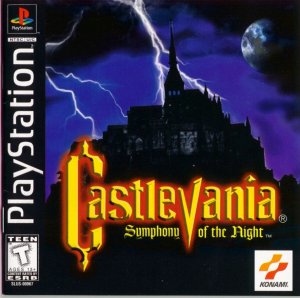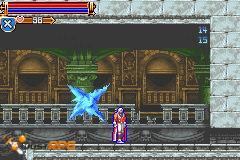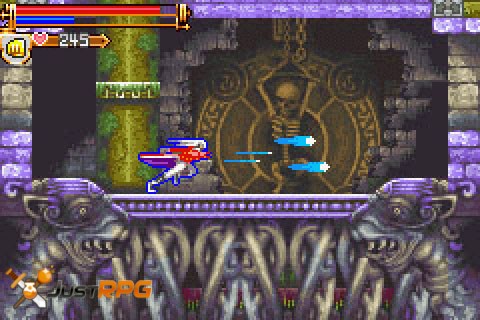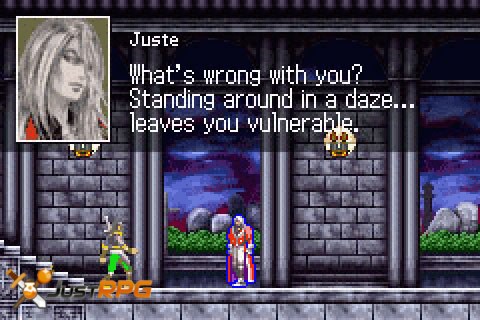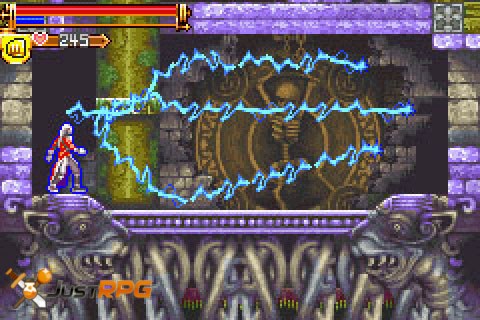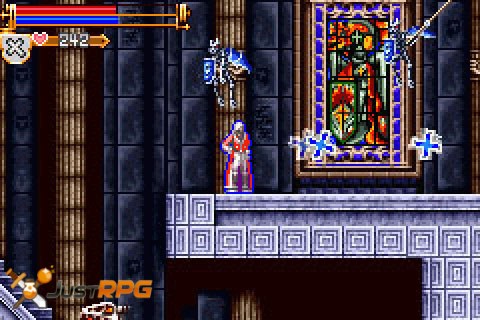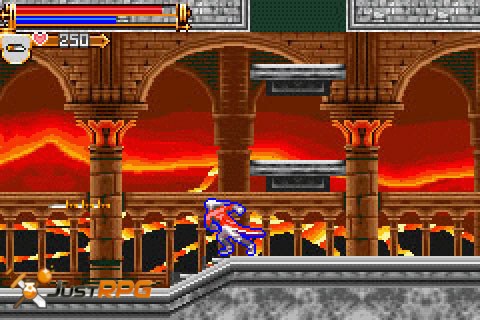Castlevania: Symphony of the Night is a continuation of the Castlevania series, and it delivers just like it’s predecessors.
Full Review
Castlevania: Symphony of the Night Review
By, Josh Ferguson
Backdrop
.hack Part 1 Infection (Dot Hack) begins with a bang. Something disastrous happens to your character‘s real world friend, while innocently playing a 20 million-subscriber base, wildly popular online RPG game (MMORPG), The World. To unravel the mystery of your friend’s misfortune, you become an online, ingame rogue hacker, exploring every corner of The World, even some virus-infected ones.
The hero is armed with the special skills of Data Drain and Gate Hack, and some colorful, talented fellow adventurers to fill the two other available party slots. Different adventurers must accompany you depending on the plot‘s development. You have some control over the others in your party, including upgrading them through trades or gifts. You can play only a single class, Twin Blade. Other characters are from different classes, with varied strengths and weaknesses, from a mage type (Wavemaster) to a bully (Heavy Axeman).
Gameplay
Gameplay takes place in three principal areas – towns, fields, and dungeons. Towns house The World’s servers. There, the player can save the game, buy magic scrolls and useful and unique items, store items, buy equipment, and talk and trade with lots of other players in character online. One town has an unusual ranch to check out, a patent homage to an enduring feature of just about every Final Fantasy.
The town’s Chaos Gate provides instant teleportation to a particular wide-open Field, containing monster encounter hotspots, a mystical spring, treasure, and lots of mysterious food. You enter three distinct keywords, some known at the game‘s onset, and others learned through play. Whatever keywords are entered, the difficulty level of the destination is helpfully revealed. This prevents a low-level party from being massacred. Once the keywords are entered, you travel through the Chaos Gate. (You can enter specific keywords learned to continue the plot, do side quests, or do unlimited exploring. Or, you can instruct the Gate to enter random keywords, and take your chances. There‘s also an option to enter any keywords you wish from a word list.) Every Field houses a single Dungeon. The dungeons, where you spend much of the game fighting for your life, are not overly large in size, and always range between three and five average levels.
Many have compared Dot Hack to Phantasy Star Online Episode I and II (PSO) on the Gamecube. Let us gently discredit this. We feel Dot Hack has far better graphics than PSO. The Fields and Dungeons contain many colorful, over stylized backdrops and settings, including weather effects. Dot Hack’s monsters resemble the beautifully-drawn monsters of the later Final Fantasy’s. Dot Hack’s world is gigantic with a seeming infinite number of locations to explore. PSO’s world is relatively small, and plot is threadbare, with meaningless, though fun, side quests, which instill no enthusiasm in the player. Dot Hack’s plot is deep and complex, with each subplot advancing the story just a little bit further. (Remember though, the end of this game in no way comes close to wrapping up the story, to be completed in the three games to be released later this year.) One visual treat, however, was lifted directly from PSO – the cascading rings that accompany the teleportation of characters to and from different areas.
Combat
Dot Hack’s combat engine can best be described as modified real-time. Much like the action-RPG, Kingdom Hearts, button mashing can be effective to beat monsters. Monster combat icons appear as large yellow twirling landmarks. As you approach, the landmark dissolves, monsters come at you big-time, and, undoubtedly, players will feel a healthy adrenaline rush. Some of Dot Hack’s many monsters do not stand around waiting to be pummeled, rather some you need to catch. Dot Hack lets you turn combat almost into a turn-based affair. The player needs only to hit Triangle in the middle of battle to pause the game instantly. From there the player can give orders to the others in the party, anything from healing someone, reviving another, casting a spell, designating a target monster. Without jeopardizing your party from the hailstorm of monster blows, combat becomes a calmer, more strategic, experience. This will help the many action-challenged. Camera angles play a big role in successful combat. You must be facing a monster to do any damage. As in many games, manipulating opposing environmental elements, like fire vs. water, is a key to successful monster combat.
Dot Hack’s cyberspace setting provides a wealth of Wow-inducing outbursts. The Data Drain option in combat is a great example. When a monster’s approaches zero, the player can Data Drain to reduce a horrendous, gigantic steel robot, for example, into a sniveling, puny monster, easily defeated with a single blow. Data Drain always results in a nifty, rare item or essential Virus Cores so you can Gate Hack areas of The World now closed, but needing investigation. One bad side effect – if you defeat, a Data Drained monster, but a single experience point is earned. One REALLY bad side effect – if you Data Drain too often without giving the skill a rest, you may overload and explode. Game Over. In the case of Boss monsters, Data Drain works the same, but what remains is no sniveling puny monster, but a full-blooded slightly less tough monster. All of this makes for interesting and captivating combat, a large part of the game.
Fresh Features
Dot Hack is replete with new and interesting features that kept us riveted.
To start, the entire background and story of a real world gamer becoming a rascal hacker, penetrating deep into a virus-infected online game, is quite novel. Combine this with Dot Hack’s emulating the look and feel of an online game universe. (Message traffic on the web shows many gamers mistakenly believe Dot Hack is a real online MMORPG, along with monthly fees! No real Internet connection is required.)
Just like in the real word, Dot Hack replicates your excitement level when “New” appears before a popular forum or on your email screen. Some of the game involves receiving emails as the plot develops, as well as new, crucial information surfacing on The World’s Board. (Look out for emails challenging you to a strange game of Tag.) The online game world looks very familiar with a bunch of characters wandering around the game’s towns, with the ubiquitous balloon icons talking typical “trash” to each other, even criticizing “newbies“.
Combat grippingly called for surprisingly strategic decision-making to succeed, not related to the usual attack or defend choices. Do you go for experience and upgrade your character or try for some special equipment or a Virus Core, vital to Gate Hacking? The innovative control of other party members became second nature to us after some practice. The game rewards a player taking chances, like entering a Field or Dungeon rated 5 levels above the player’s current level. On the other hand, the game scoffed at players entering areas much lower rated the their current level, by awarding negligible experience points for victory.
Dot Hack takes progress reports to a new level, by slowly unlocking books that contain much in the way of statistics and information. There’s even a monster compendium with tips for defeating them.
Some might complain about the minimal “Save Game” ability, but we thrived on it. You explore a very hostile cyberspace environment without the facility to save. Only in a server-hosting town is saving possible at the local Recorder. We may be a solitary voice in the Wilderness, but we like this throwback to the good old RPG days. Those of you old enough to remember the Wizardry series, may recall those fingernail-biting multi-combat treks back to the Castle just to save the game. In case you’re really stuck deep in a dungeon, a common item will teleport you to the outdoor field, from where you can simply gate back to town from the command menu.
Many pieces of equipment come with distinctive powerful attack, healing, and status skills, essential to combat dominance. The player must tradeoff whether to equip something that will raise defense or offense or something less vigorous that lets you use a powerful skill. Trading is the most successful way to upgrade equipment.
In a first, Dot Hack comes with a 45 minute anime video. This gives some great background on what’s going on in The World, as well as provide clues for completing the game. In a nice twist, voiceovers for game speech can be set for Japanese or English presentation. Listening to the authentic Japanese voices really keeps you glued to the game.
Though some may scoff at what follows as meaningless, we liked the game’s unlocking of some nifty new “toys” to like, some only available when the game is cleared. You can unlock many different background music play lists. Tired of creepy tunes, just switch to something more upbeat, or futuristic. Just like real world gamers, who constantly change their desktop wallpaper, new and different wallpapers are unlocked along the way. Some are concept art of characters, while others are full blown anime renditions of the characters. This makes for great fun, and seems to pump additional energy into the game. As you progress over a dozen special cut scenes or movies will become viewable after defeating the game.
Though Dot Hack’s extras and new wrinkles enhance the RPG game experience, much of the gameplay will ring true to those who enjoy RPG‘s. Expect plenty of exploration in a huge 3D world, frequent monster combat, tons of treasure to earn and discover, upgrading your character’s weapons and armor, and needing to level before tackling pivotal story dungeons. The status screens for the characters and all equipment are well laid out and easy to grasp.
Time for Completion
Game length in hours always concerns many purchasers. A short RPG normally takes a lot of flack, and many online are asking about Dot Hack‘s time for completion. (Some have questioned whether Bandai should have released a single 80 hour game for $50, rather than four 20-hour games for $200 for a single story. This matter is beyond the scope of this review, but our high opinion of this game as a standalone is obvious.) Our experience, playing the plot without doing side quests or extra exploration, is in the 12 to 15-hour range. Players side-questing and extensively exploring, aside from the main plot, can expect to spend 25 hours to complete the game. You can even continue to advance your character, after game completion, to get a jump start on Part 2 due in May. In the next game, your character can be imported from Part 1.
Furthermore, imagine trying to explore every nook and cranny of the fields and dungeons accessible by a large number of 3-word combinations. Doing that would put the game in the 50-hour range, if not more. However, at a certain point, new items dry up, and a single experience point is earned for any defeated monster, no matter how tough.
Shortcomings
While, as is evident above, there is much to recommend in Dot Hack, certain concerns to varying degrees deserve mention.
From the “Why oh why did they leave this out?“ File. Pregame game board traffic and information about the Japanese version released months ago had many salivating for replaying the game in “parody” mode. This mode apparently converted all Dot Hack’s game world characters into satirical comedians. Sorry to say, this highly-anticipated feature is missing from the version released here.
The game requires massive amounts of button pressing. Every item or treasure uncovered from combat victories or exploration (opening chests, searching expired adventure remains, collecting food for Grunty’s, as examples) must be confirmed with a button press. When there could be 50-100 such occurrences in a single dungeon or field, over the course of the game, finger cramps seem inevitable. Baldur’s Gate: Dark Alliance also required lots of bashing for buried treasure and chests, but the items literally flew into your inventory, a much better way to handle this.
The manual is woefully terse and lacking in some crucial information and guidance. While the ingame tutorials fill in many of the gaps, one extremely important gameplay feature is missing from both the manual and tutorials – instructions on control your characters directly during combat.
Final Word
We got a kick out of Dot Hack. The feeling of “just one more dungeon” dominated our lives for the 3 days to completion. The engaging environment held our attention without much effort. The strategic nature of combat, plus the convoluted plot kept us going for hours on end. The constant unlocking of both frivolous and important gameplay features created a “what’s next” anticipation. Now, if I could only read Japanese better, Dot Hack Part 2 is already out in Japan!
Final Grade: B
Castlevania: Symphony of the Night was the first game in the series to be released for a PlayStation console. While the game certainly is dated, it is still one of the best in Konami’s popular series. Not only is it one of the best in the series, but one of the best games to be released for the original PlayStation console.
The story in Symphony of the Night revolves around Alucard, the son of Dracula, who appeared in Castlevania 3: Dracula’s Curse. After the events of Dracula’s Curse, Alucard decided to go into an eternal sleep, but was awoken after his father’s castle suddenly reappeared. Alucard has once again vowed to stop the evil that exists in Dracula’s castle.
With Symphony of the Night, Konami changed many of the aspects of the Castlevania series. First of all, this was one of the first times that your playable character is someone outside of the Belmont clan. While there are hints that Alucard is somehow linked with the Belmonts, this is one of the first times where players do not take on the role of an actual Belmont. Also, Alucard doesn’t wield a whip that has become ever popular in the series. Instead, Alucard uses a wide variety of weaponry, including swords, daggers, and clubs, and can even use his fists to attack enemies. That’s not all either, some of the weapons Alucard can equip have special skills attached. For example, one might drain the life of an enemy and another might summon the dead to fight alongside you for a time. Symphony of the Night features a large inventory of weapons, other then the predecessors that only carried a whip, and many have their own unique abilities and stats.
Symphony of the Night is also the first time that a Castlevania game has been mainly focused as an RPG. By defeating enemies throughout the game, Alucard will gain different amounts of experience. As he obtains a certain level of experience, Alucard will level up and his stats will increase. While leveling up is quite different than the games before it, this makes Symphony of the Night’s difficulty level much easier than the earlier games, as well.
Throughout Dracula’s castle there are also relics that must be acquired in order to progress in the game. There are many different types of relics that affect Alucard in many different ways. Some relics enable Alucard to take the form of different objects, allow him to walk in water, allow a super jump, and much, much more. There are also relics that give Alucard a different familiar. There are a few familiars that include a fairy, a winged demon holding a spear, and a large sword. The fairy is strictly used for healing and protection, while the other two have the ability to attack. Only one of these familiars can be equipped at a time, but as you gain experience, so does the equipped familiar. As these familiars level up, they not only become stronger, but also obtain the occasional new abilities.
For those of us who are familiar with the Castlevania series, we all remember that in Dracula’s Curse, Alucard was able to launch fireballs and take on the form of a bat. Symphony of the Night takes those ideas and adds some extra. Not only can Alucard take on the form of a bat, but he can now also transform into a wolf and mist. All of these forms have their own advantages, and in order to complete certain parts of the game, will probably have to be used. As Alucard transforms, his magic bar will begin to decrease. However, it can be restored by going back into your normal Vampire form. Alucard can also perform several more magic spells including one that steals life from enemies, a spirit that will damage all enemies on the screen, and the same fireballs that were available Dracula’s Curse.
Other than the introduction of spells, leveling up and so on, the actual gameplay in Symphony of the Night hasn’t changed much from the earlier games. In Symphony of the Night, Alucard will travel through certain points of the castle and will basically do all of the fighting that the Belmonts did before him, but with a different weapon. But, the main difference between Symphony of the Night and the earlier Castlevania games is the actual controls. While the earlier Castlevania games featured controls that didn’t seemed very sluggish, Symphony of the Night flows well and looks great. The controls have definitely improved and are much easier to use.
Like I said earlier, graphically Symphony of the Night is definitely dated, but for its time the graphics look great. The actual characters, especially Alucard look great, and the backgrounds have an excellent gothic style that has made the series so great. The game also features an absolutely amazing soundtrack which, to this day, is one of the best that I’ve ever heard in a videogame.
Symphony of the Night also has a little bit of replay value along with it. Not only does the game feature a few different endings, but after completion you can replay the game using Richter Belmont! However, Richter’s play through is quite different than Alucard’s, and doesn’t feature the option of equipping all of the weapons that Alucard could. In fact, the game is pretty much changed into an original Castlevania game, with no leveling up, no stats, no inventory, and so on.
In regards to the Dreamcast version, Richter Belmont is a playable character from the beginning of the game, and does not need a completed save file. Also, this version features Maria Renard, sister-in-law of Richter’s, who was seen in Dracula X. This version also features extra equipment and a few more familiars, but on the downside, it doesn’t have any English voice-acting. While some of these extras might sound nice, you might want to stick with the PlayStation version.
Overall, Castlevania: Symphony of the Night is one of the best games available for the original PlayStation. With all of the new features available, Symphony of the Night is very different from the previous games in the Castlevania series, but it also stands out as one of the best. If you are an RPG fan, or just a fan of the Castlevania series, this game is highly recommended. And even if you aren’t a fan of the series or of RPGs, I still recommend the game.
Final Verdict: 94%

